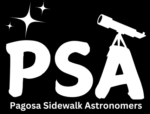Protecting Pagosa’s Dark Sky
Pagosa Springs is a beautiful mountain town in Southwest Colorado. Our dark sky is rated as class 3-4 on the Bortle scale meaning the Milky Way and many stars can be seen with the naked eye. You can even see some Deep Sky Objects such as the Pleiades and the Andromeda Galaxy. Slightly out of town, the even darker sky allows for telescope viewing of many more objects! We are working to preserve and protect Pagosa’s dark skies through outreach and education, fostering a deeper appreciation for our natural night environment.
As dark sky advocates, Pagosa Sidewalk Astronomers take actions such as:
- Educating the public and policymakers on the importance of dark sky conservation
- Mobilizing support to reduce light pollution for future generations
- Promoting responsible outdoor lighting
- Working with local government to assess, measure, and improve outdoor lighting
- Pursuing certification of Pagosa Springs as a Dark Sky Community by DarkSky International.
![]() Losing the Dark on YouTube (6.25min)
Losing the Dark on YouTube (6.25min)
- Glare – excessive brightness that causes visual discomfort (especially for older eyes or eyes developing cataracts)
- Light trespass – light falling where it is not intended or needed
- Skyglow – brightening of the night sky over inhabited areas
- Clutter – bright, confusing, and excessive groupings of light sources
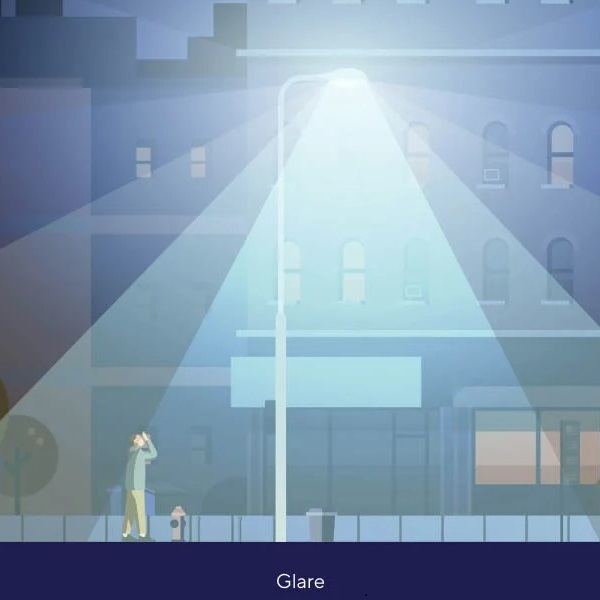
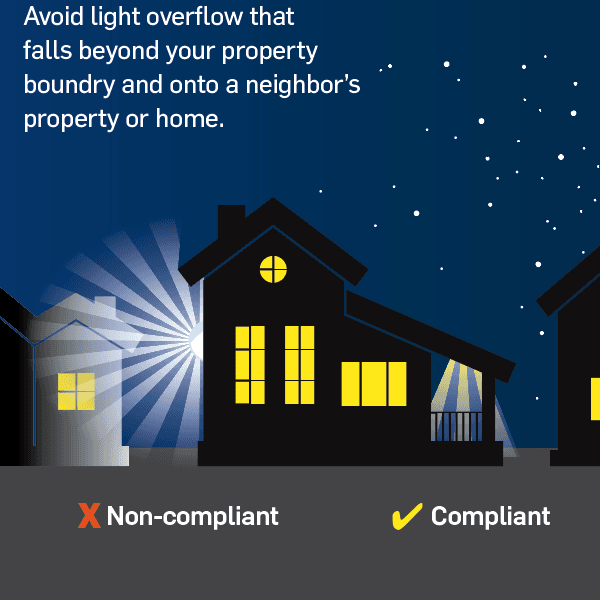
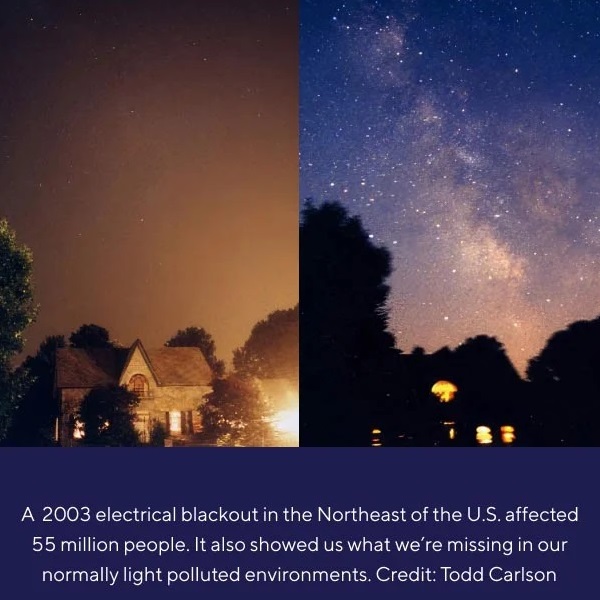
How Do We Reduce Light Pollution?
The good news is that light pollution is reversible. Turning off lights when they are not needed is the simplest way to reduce it. Adding timers can ensure lights don’t stay on all night. Programmable timers, like this Leviton and this Honeywell (or this Intermatic for commercial use), allow you to set your latitude to turn lights on at sunset, off at 11pm, back on at 6am, and off again at sunrise. You can use the same program all year no matter how short or long the days are. For all outdoor lighting, following the below five principles greatly reduces the amount of light sent upwards into the atmosphere causing skyglow. Lights in front of businesses, in public areas, or in shared outdoor space may need bulbs with more lumens than residential lights, but should still be warm in color (3000K or less). Every outdoor light should be fully shielded so that the bulb is not visible from the side. Home lighting need not be brighter than 450 lumens and 2700K. For more information, download the Dark Sky Friendly Home Lighting Guide PDF from DarkSky International.
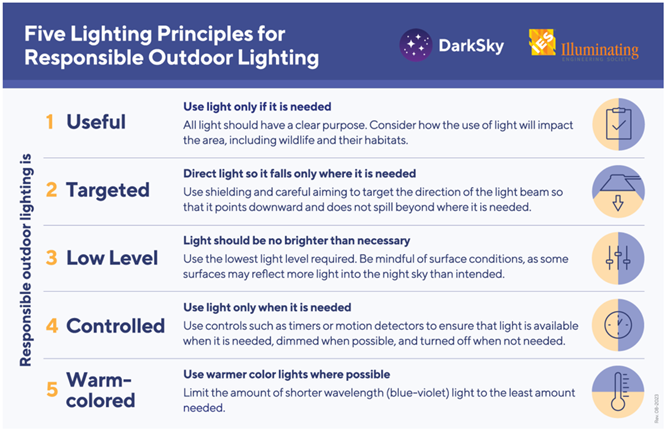
What can I do to make a difference?
Community involvement is key! To preserve and protect Pagosa’s dark skies, we need to work together as a community to earn recognition as a Dark Sky Community and maintain that status. You can help by being involved in educational outreach. Pagosa Sidewalk Astronomers are planning dark sky campaigns and night sky events this year and in the coming years. If you would like to assist PSA with local advocacy or astronomy-based events, please contact us!
Every citizen can make a difference by assessing their own outdoor lights. Take action starting with your own residence. Start by doing a home lighting assessment and get a free window decal from DarkSky International! Make a few simple, one-time changes and register your home as a Dark Sky Friendly Home. You’ll love the way it beautifies your home’s exterior.
BETTER LIGHTS FOR BETTER NIGHTS!

Consider donating to DarkSkyColorado.org, or becoming a Dark Sky Advocate with DarkSky International! It costs nothing and connects you to other advocates and experts across the globe.

Frequently Asked Questions
How would being recognized as a Dark Sky Community benefit our town?
Dark Sky Communities allow residents and visitors a clear view of the night sky for generations to come. Dark Sky Communities potentially see a boost in tourism with their official designation. Astrotourism is trending because most people live in light polluted cities, they specifically travel to more rural places to experience less light pollution. View the Light Pollution Map for Pagosa Springs and click on a particular location to see details.
The dark sky movement is gaining momentum around the world and especially in Colorado! Nearby Durango, CO has recently been selected as a recipient of the Colorado Dark Sky Certification Mentorship Program. Colorado one of the states leading the U.S. in the number of recognized Dark Sky Places. Incidentally, homes in recognized dark sky places have been shown to increase in value.
Key benefits of dark sky recognition:
- Improved quality of life: Reduced light pollution can contribute to better sleep patterns and overall wellbeing for residents. See this article from the National Library of Medicine called Missing the Dark: Health Effects of Light Pollution
- Economic boost: Communities with dark sky recognition can attract more tourists interested in stargazing and experiencing a clear night sky, which can benefit local businesses.
- Environmental conservation: By reducing light pollution, dark sky initiatives protect nocturnal wildlife that rely on darkness for navigation, mating, and hunting.
When is International Dark Sky Week?
April 13-20, 2026
Dark Sky International, headquartered in Tucson, Arizona, is the globally-recognized authority on light pollution. They created International Dark Sky Week to raise awareness of light pollution, provide free education, resources, and solutions to the public to encourage the protection of and enjoyment of dark skies with responsible outdoor lighting.
International Dark Sky Week is an annual, international celebration held during the new moon in April. People worldwide turn off their lights to observe the beauty of the night sky without light pollution. You can also celebrate by going outside with family or friends by looking at the night sky using the naked eye, binoculars, or a telescope! This is also a great time do to your own advocating for dark skies by talking to friends, neighbors, and local system of governance.
I'm concerned with safety. Isn't brighter light safer?
Quality lighting is safer.
It is human nature to think that brighter light reduces crime. This is generally based on the notion that more light improves visibility, and this visibility discourages criminals, but studies have shown that this is not always the case. Some studies report theft and property crime is more prevalent during daytime hours. Vandalism is an example where security lighting has the opposite effect of what is generally believed. Studies conclude that lit areas are subject to more vandalism and graffiti.
This image shows how glare from a light fixture actually creates shadows where intruders can more easily hide. Downward-facing lights with warmer tones create an environment that is easier for the human eye to detect details in the surrounding area. Read more about light pollution's effect on crime and safety. Changing your bulbs from 750 lumens (9W) to 450 lumens (5W) would pay for itself in about 8 months, depending on how long the lights are left on. Use this Energy Savings Calculator to determine how much you could save!
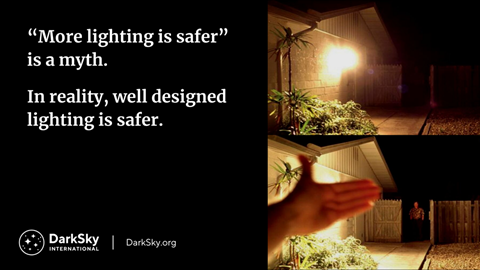
Why should I be concerned with dark skies?
Minimizing light pollution isn’t just about seeing the stars. There are other important things at stake, too. Take the time to learn more about the effect of artificial light at night on human health, harm to wildlife and the ecosystem, energy and climate, crime and safety and our heritage of night skies. See this article on the American Medical Association's website entitled We're All Healthier Under a Starry Sky.
Viewing the night sky from a dark location is incredible! We all share a universal heritage in the starry night. There are between 1000 and 2000 stars visible with the naked eye, but sadly, people in many locations see nowhere near this many stars.
Every light alters the night. Did you know that an estimated one-third of humanity and 80% of Americans cannot see the Milky Way? Light pollution has gotten much worse in recent decades. The San Luis Valley and all along the highway 160 corridor across southern Colorado has advocates working to preserve the night sky. If we don’t act now, we will lose the ability in our community.
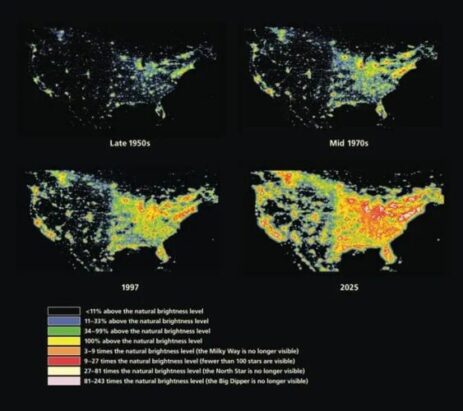
What are dark sky approved fixtures and where can I purchase them?
Dark Sky International approves light fixtures so you can rest assured they are downward-facing/shielded to minimize glare and reduce light trespass. See their website for more information on approved fixtures.
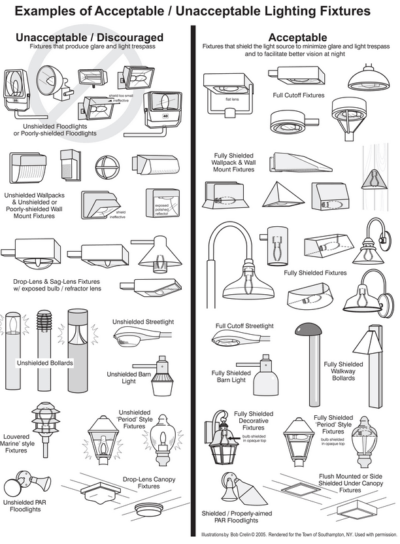
Is it necessary to replace all of my non-compliant outdoor fixtures?
Possibly not. You may be able to simply aim the light downward. Also, many lighting manufactures have shields that can be added to their fixtures. Unshielded lights are visible for “as far as the eye can see”. Shielding luminaires is critical for cutting widespread glare. Shielding improves visibility and the light's impact on the environment beyond the target area. The shield should completely cover the bulb to prevent light from exiting horizontally. Pathway lights that do not exceed 12 lumens do not need to be shielded. 2-3 watt led bulbs with warm color (2700K) work well for pathways. See a light shield demonstration video here. Ceiling mounted can lights and lights hidden by eaves do not need to be shielded.
Porch lights typically use 450 lumen 2700K bulbs. If you currently use 750-800 lumen (9W) bulbs in your outdoor fixtures and replaced them with 450 lumen (5W) bulbs, they could pay for themselves in less than 8 months depending on how long the light is on. Use this Energy Savings Calculator to see what you could save.
Consider adding lighting controls. Timers and motion-sensors both help create dark sky lighting by ensuring outdoor lights are only on when needed, minimizing the hours light is emitted into the night sky. Motion-activated lights should turn off in 5 minutes or less. It is also a good habit to turn off your outside lights before you go to bed. The Calculator will also help you determine the savings a timer could provide. If you prefer your lights on all night, consider adding a dimmer to reduce their output between the hours of 11PM and 6AM. Make sure the dimmer will work with LED lights and that the bulb is dimmable. Some commercial lighting has controllers separate from the bulb. In this case, the bulb would not say "dimmable". Here is a Guide to Dimming LEDs: How to tell if your Lights are Dimmable.
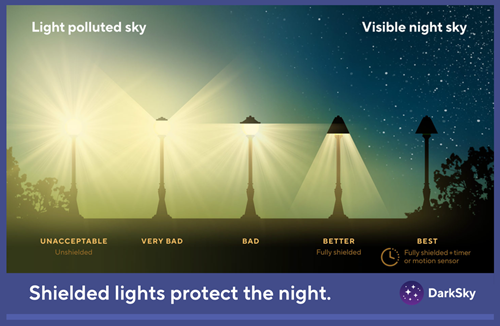
What is meant by warm-colored bulbs?
Light temperature (or Corelated Color Temperature) is measured in Kelvins. The greater the number, the more light is emitted on the blue end of the spectrum. Blue light scatters more readily into the atmosphere and is a major cause of skyglow. Excessive blue light at night can also disrupt the natural rhythms of nocturnal animals. Warm lights having an orange-ish hue are more pleasing to the human eye as well.
Using warmer bulbs with less lumens can save you money on your electric bill. Changing from 800 lumens (9W) led bulbs to 450 lumens (5W) bulbs will pay for themselves in less than 8 months depending on how long they are left on. Use this Energy Savings Calculator to see how you can save money.
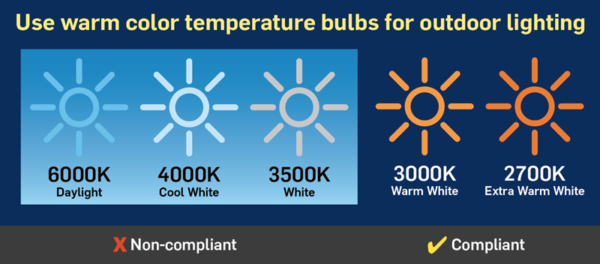
What is the difference between watts and lumens and how can I save money?
Light pollution wastes energy. In the US alone, outdoor lighting consumes about 380 tWh every year. That's enough to power 35 million homes. Watts measure energy consumption, while lumens measure brightness. These days, we are not as concerned with energy consumption because LEDs use far less than incandescent bulbs, but using overly bright bulbs does use more energy. Lighting should use the fewest amount of lumens that is correct for the task. The free Lux Light Meter Pro app for iPhone or android can be used to determine a bulbs lumens without removing it to read the fine print.
Dark sky compliant luminaries emitting 800 lumens or less work in most situations. Bulbs with 450 lumens is recommended for porch lights. Changing from 800 lumens (9W) led bulbs to 450 lumens (5W) bulbs will pay for themselves in less than 8 months depending on how long they are left on. Use this Energy Savings Calculator to see how you can save money. The LPEA website will show you cost per kilowatt during peak and off-peak hours.
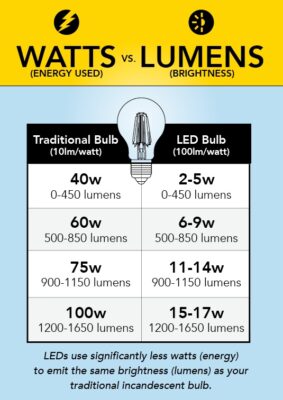
My neighbor's light shines onto my property or into my window. What can I do?
Light trespass is a common problem, but is usually not intentional. Talk to your neighbor about the above Five Principles of Responsible Outdoor Lighting. Or, if that makes you uncomfortable, Dark Sky International has a Sample Letter to Your Neighbor which you can use to begin the conversation on Light Trespass. Download the letter in RTF format or DOCX format. If you need to, report violations to your local government, HOA, town, or county.
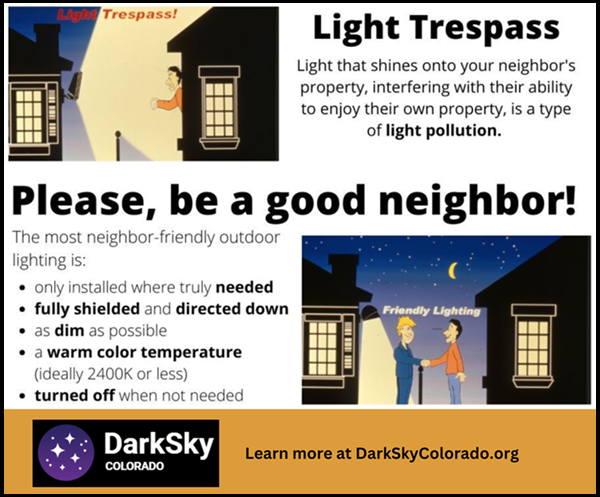
How is light pollution measured?
A Sky Quality Meter (SQM) is a device used to measure the luminance of the night sky. We take readings at various locations in and around Pagosa Springs. Measurements are taken on moonless nights each season and are used to assess light pollution. Learn more here.

